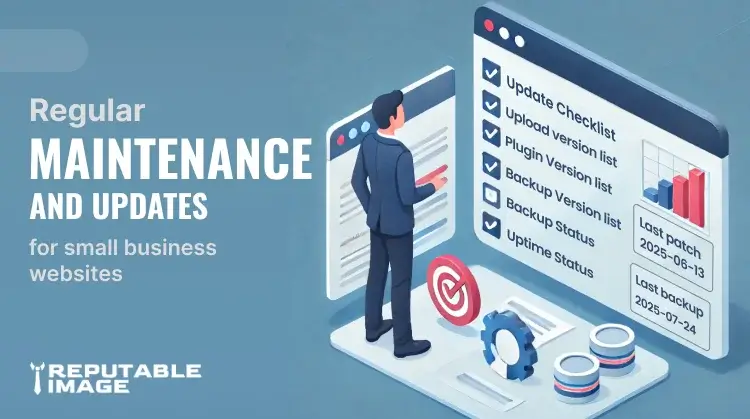
Regular Maintenance and Updates
for Small Business Websites
Regular maintenance and updates for small business websites should be part of every owner’s plan. Keeping software updated, backups current, and security monitored protects your brand, customer data, and sales channels. This guide explains what to check, a practical schedule, and the business benefits of staying proactive.
Why Maintenance Matters
Websites are software — and software needs care. Unpatched plugins, expired certificates, and outdated themes create security holes that attackers exploit, and they can also break pages or slow performance. Regular maintenance reduces the risk of hacks, downtime, and the reputational damage that follows. (Mailchimp)
The Top Pain Points
Maintenance Solves
First, security vulnerabilities: many small sites are targeted because they’re easier to breach. Second, performance problems: slow pages lose customers and harm search visibility. Third, broken functionality: outdated plugins can break forms, payment flows, or booking widgets at the worst times. Fourth, downtime costs: outages can be expensive in lost sales and staff hours to fix. Monitoring and updates address all of these. (IT Pro)

Core tasks:
What to do and how often
Keep this simple and repeatable — your maintenance plan should include daily, weekly, monthly, and quarterly tasks.
Daily: Monitor uptime alerts and recent backups.
Weekly: Update plugins/themes, scan for security alerts, review forms and contact methods.
Monthly: test backups by restoring in staging, check site speed metrics, and review analytics for unusual drops.
Quarterly: Run a full site audit (SEO, accessibility, link checks), renew SSL certificates early, and validate structured data.
Automating parts of this (scheduled backups, automatic security scans) reduces effort and ensures you don’t miss crucial steps. Use a staging site for updates when possible to test changes before they go live.
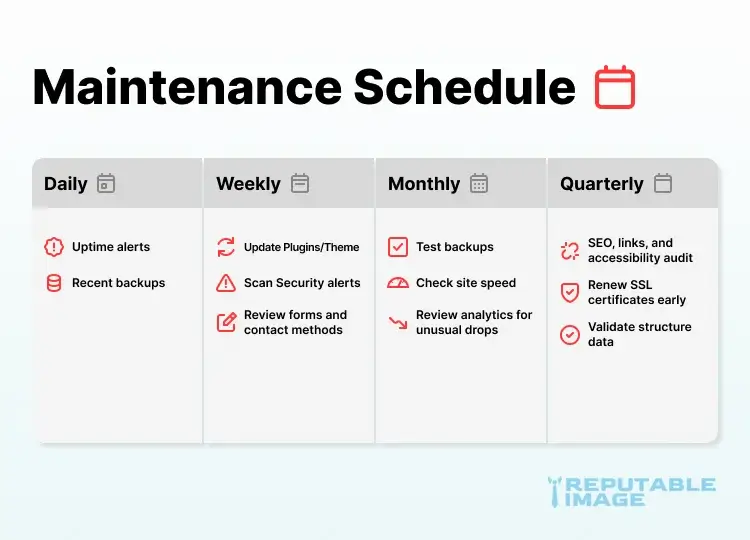
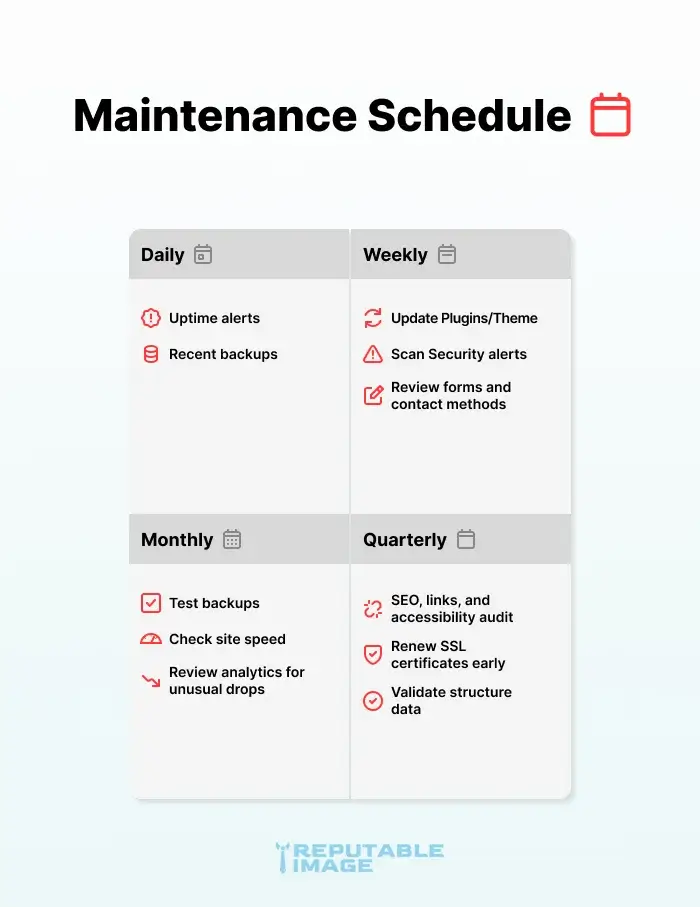
Backups Are Your Safety Net
Backups are not optional. A good plan includes automated daily backups (or at minimum nightly) with at least one off-site copy and versioned restore points. Practice restores at least monthly — a backup that can't be restored is useless. In many hacks, the fastest way back online is a recent restore rather than a long rebuild. WP Engine and other managed hosts provide integrated backup and restore tools that simplify this. (WP Engine)
Updates:
Core, Themes, and Plugins
Apply updates on a regular schedule, not sporadically. For WordPress sites, update the core, theme, and plugins weekly (or when critical security patches are released). Test updates on staging first if your site supports it. Where auto-updates are safe (minor security patches), enable them to reduce exposure windows. Keep a short change log so you can trace when issues start. Choose templates carefully—read The Benefits and Drawbacks of Website Templates for a decision matrix.
Monitoring & alerts:
catch problems early
Monitoring is the “eyes on the site.” Uptime monitoring tells you when the site is down. Performance monitoring reveals slow pages. Security monitoring flags suspicious files, login attempts, and plugin vulnerabilities. Configure alerts for the small-but-critical events so you and your team are notified immediately and can act before customers complain.
Performance maintenance:
Speed Also Matters
Regularly optimize images and review caching. Clear or rebuild caches after major updates. Keep a small image optimization workflow and use modern formats (WebP where possible). Periodically run performance tests and prioritize fixes that deliver the biggest perceived speed improvement for users.
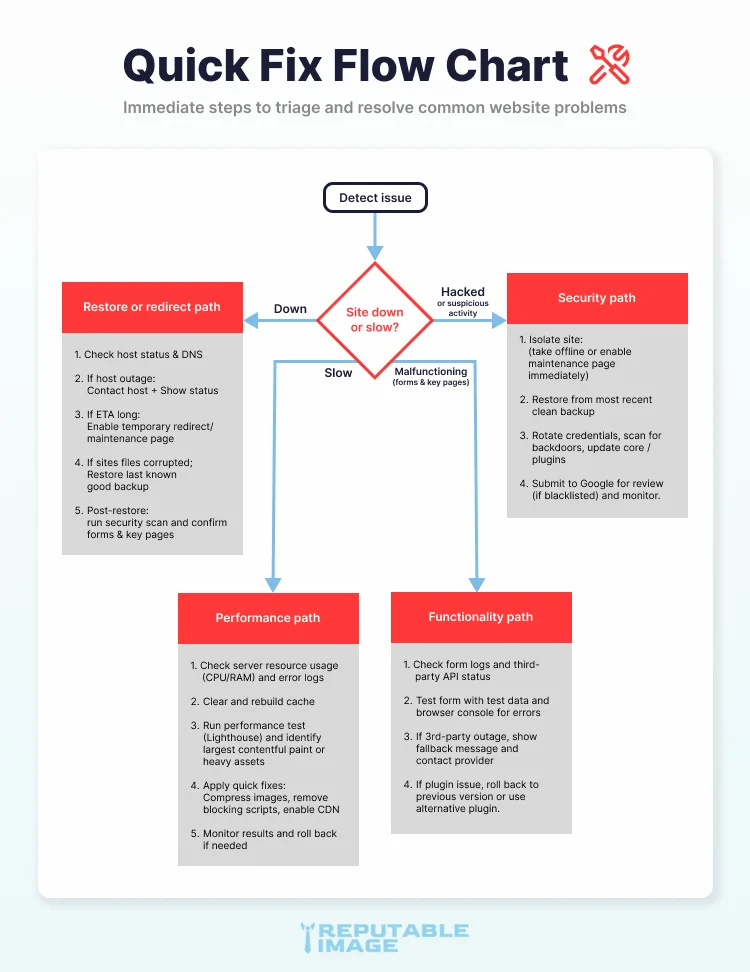
Content & SEO Maintenance
Maintenance isn’t only technical. Keep content fresh: update contact info, open hours, services, and testimonials. Remove outdated promotions and fix broken links. Search engines reward accurate, fresh content — regular audits help protect rankings and usability. Perform copy updates regularly to reduce confusion and support conversions, read Copywriting Strategies for Small Business Websites to give you ideas and guide you in your copywriting endeavours.
Small-business-friendly hosting and backups
Choose a host that provides automated backups, staging, and security by default. Managed hosting options can reduce the technical overhead and let you focus on the business. However, always know how to export your site and where your backups live — portability matters if you ever change providers. (IT Pro) (WP Engine)
A simple monthly maintenance checklist (actionable)
- Verify automated daily backups and perform one manual restore test.
- Update core, theme, and plugins on staging, test, then deploy.
- Run a security scan and review any flagged items.
-
Test top 3 user journeys:
(homepage → service → contact/checkout).1 - Optimize images that significantly impact page size.
1 Speaking of testing user journeys with UI/UX Best Practices for Small Business Websites to remove friction for your customers and increase conversions.
Pricing & packaging ideas for site owners
Maintenance can be a low-cost monthly retainer ranging from basic monitoring and backups to full-service plans that include content updates, analytics checks, and small UX improvements. Treat maintenance as insurance — a predictable monthly expense that prevents large one-off technical emergencies.
Long-term benefits for small businesses
Regular maintenance reduces the risk of catastrophic outages and data loss, keeps search performance steady, shortens support response time, and increases customer trust. Over time the cumulative cost of avoided downtime, fewer security incidents, and better SEO usually exceeds the cost of a modest maintenance plan.
Where to start — quick wins
If you’re starting from zero, prioritize: (1) automated backups and a restore test, (2) uptime monitoring, and (3) weekly plugin/theme updates on a staging environment. From there add performance checks and a monthly content audit. Save the following Cheat Sheet
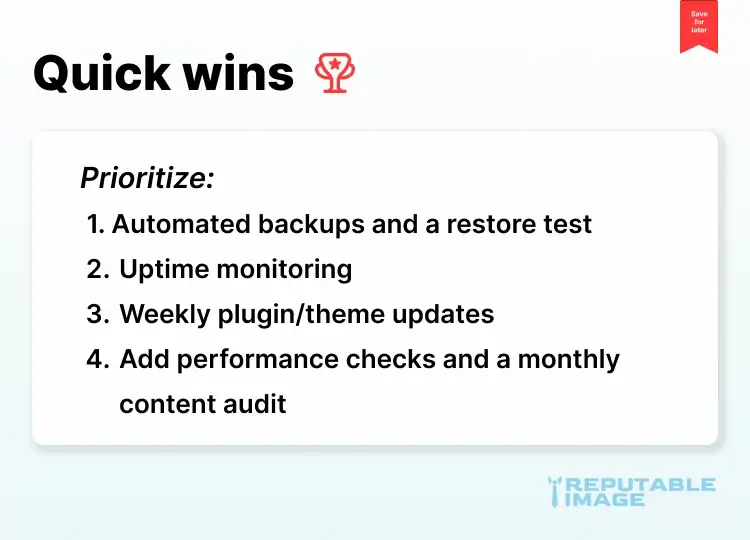
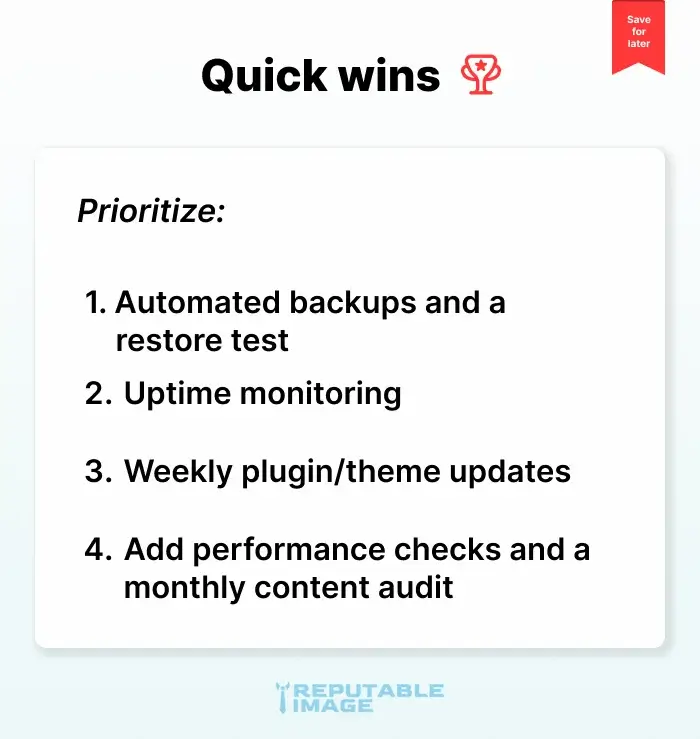
Conclusion: Wrap to services
Regular maintenance and updates protect your website, customers, and brand. At Reputable Image, we website packages with maintenance and backups included. Contact us and you'll have a site completely set up, restorable, with weekly backups, and scheduled maintenance, all included with all packages.
Sources:
1. Mailchimp - "What is Website Maintenance and Why is it Necessary?"
https://mailchimp.com/resources/website-maintenance
2. WP Engine - "What are WordPress Maintenance Plans (and how to Create your Own!)"
https://wpengine.com/resources/wordpress-maintenance-plans
3. IT Pro - "Website downtime costs businesses thousands a month"
https://www.itpro.com/infrastructure/web-hosting/website-downtime-costs-businesses-thousands-a-month

